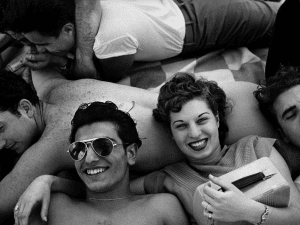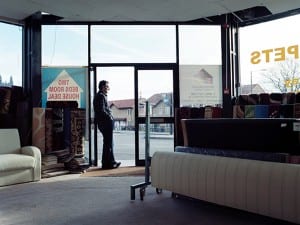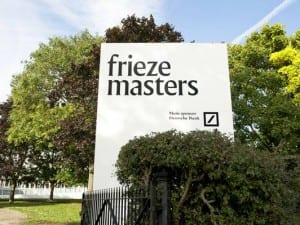As much as it might seem provincial that non-western art is categorised by geography and ethnicity, Here and Elsewhere at the New Museum, New York, does justice to this grouping. Encompassing a vast territory of over 15 countries in the Middle East that include Iran, Syria, Lebanon, Egypt, Turkey, Palestine, UAE, and Morocco, the question of fetishising locality at the cost of undermining high standards of art is met head on. Here we see artistic productions by artists challenged by exile and war.
Violence, devastation, and history often dictate the artists’ choice of medium and art making processes that explore the significance of image making as a viable tool. Issues of nationalism are embraced by the practitioners as they return to the topic of their homeland and cultural heritage, and questions of identity highlight their differences yet come together in their shared collective purpose.
For Iranian born Rokni Haerizadeh who lives in Dubai, depiction of human perversion and lack of morality pervades through his art. In a series of haunting works titled Fictionville (2011) surreal representations and macabre humor emanate from his painted newspaper clippings of strikes, women’s rights, and political uprisings that are brutally squelched in Iran. Gruesome animal masks showcase savagery and shock spectators from their passive consumption of violence through the media.
Imagery in works by other non-resident artists, like the nomadic Egyptian painter Anna Boghiguian, and Syrian born Marwan who lives in Berlin, has the same raw urgency and impact. In her Untitled (2011) series Boghiguian’s paintings consist of dark swirls, grids, narrow passages, and feverish brush strokes. Cumulatively they account for visceral images of her observations of hardship and toil in Cairo that appear to be taken from a painterly diary.
By the same token, Marwan’s often contorted portraits of disproportionately sized bodies appear cryptic and challenging. Unlike Boghiguian’s fervent gestures that draw the viewer, Marwan’s human figures are compelling precisely for their painfully articulated forms made outside the mimetic realm. Painted in palettes of browns and beiges, Mann am Tisch, (Man at the Table 1) (1966) and Stehender (Standing), 1966, are striking for capturing the essence of the unfathomable human condition.
Identity as a nationalistic concern, especially for expats such as Simone Fattal can be traced to the past, which continues to reside in her psyche and by extension in her work. For example, many of Fattal’s sculptures reference ancient architecture. Made in California long after leaving Damascus, Syria, Fattal’s rugged terracotta arches and monoliths Deesse Prehistorique (2008) and Gilgamesh (2008) recall Mesopotamian history and prehistoric artifices.
Architecture also becomes a poignant symbol for a place and its history in Marwan Rechmaoui’s Spectre, (The Yacoubian Building) 2006-08. The artist’s desolate scaled replica of the building he evacuated in Syria during the Israeli occupation of 2006 is a strong marker of home and belonging. Art drawn from such traumatic experiences imparts a deep sense of pathos and longing for a culture removed and silenced overnight.
Similarly Wafa Hourani’s Qalandia, 2087 (2009) is a large-scale futuristic production of a housing complex in his hometown Ramallah, Palestine. Alluding to the security checkpoint that divides the West Bank in Israel, Hourani’s dream of a peaceful home is thwarted by his understated but powerful use of filmstrips to block the windows from portraying his fantasy.
Authenticity runs deep in these works as they unravel the enormous loss of life, culture, and humanity in the Middle East without being maudlin. Narratives such as Mounira Al Solh’s powerful video Now Eat My Script (2014) is an unconventional but insightful and moving take on civilians caught in the cross fire of wars. A slaughtered lamb and exchange of goods and food explores the transient notion of home and dislocation for current Syrian refugees in her hometown in Beirut Lebanon, and the artist’s own memories of fleeing to Damascus during the Lebanese Civil War.
Yet for Ziad Antar who was born in Saida Lebanon and divides his time between Paris and Beirut, grainy, faded images from the Expired series, 2009, of abandoned structures in his country made with expired film and a 1948 Kodak Reflex Camera reflect on the accuracy of archival imagery and colonial representations of history. For him the notion of home is obfuscated through a lens that questions the verity of presenting images.
Ideas of identity, home, and country are presented through an array of individual practices that are representative of a region long embroiled in conflict. Inspired by the title of Goddard’s film that was meant to be about the Palestinian Revolution but in fact examined the function of images and representation, Here and Elsewhere provides a nuanced and rich selection of works that take on complex political situations and serves as a model for many more shows to come.
Here and Elsewhere, until 28 September, New Museum, New York.
Bansie Vasvani
Follow us on Twitter @AestheticaMag for the latest news in contemporary art and culture.
Credits
1. Shuruq Harb, The Keeper, 2011–13 (detail). Installation with video, includes photographs, wires, clips, and street sign, dimensions variable. Installation view: Darat al Funun, Amman. Courtesy the artist. Photo: Bashar Alaeddin.
2. Jamal Penjweny, Saddam is Here, 2010. Chromogenic print, 23 5/8 x 31 1/2 in (60 x 80 cm). Courtesy Ruya Foundation for Contemporary Culture in Iraq.
3. Fouad Elkoury, Color snapshot, Place des Canons (Beirut 1982), 2014. Digital inkjet print, 15 3/4 x 23 5/8 in (40 x 60 cm). Courtesy the artist, the Third Line, Dubai, and Galerie Tanit, Munich/Beirut





